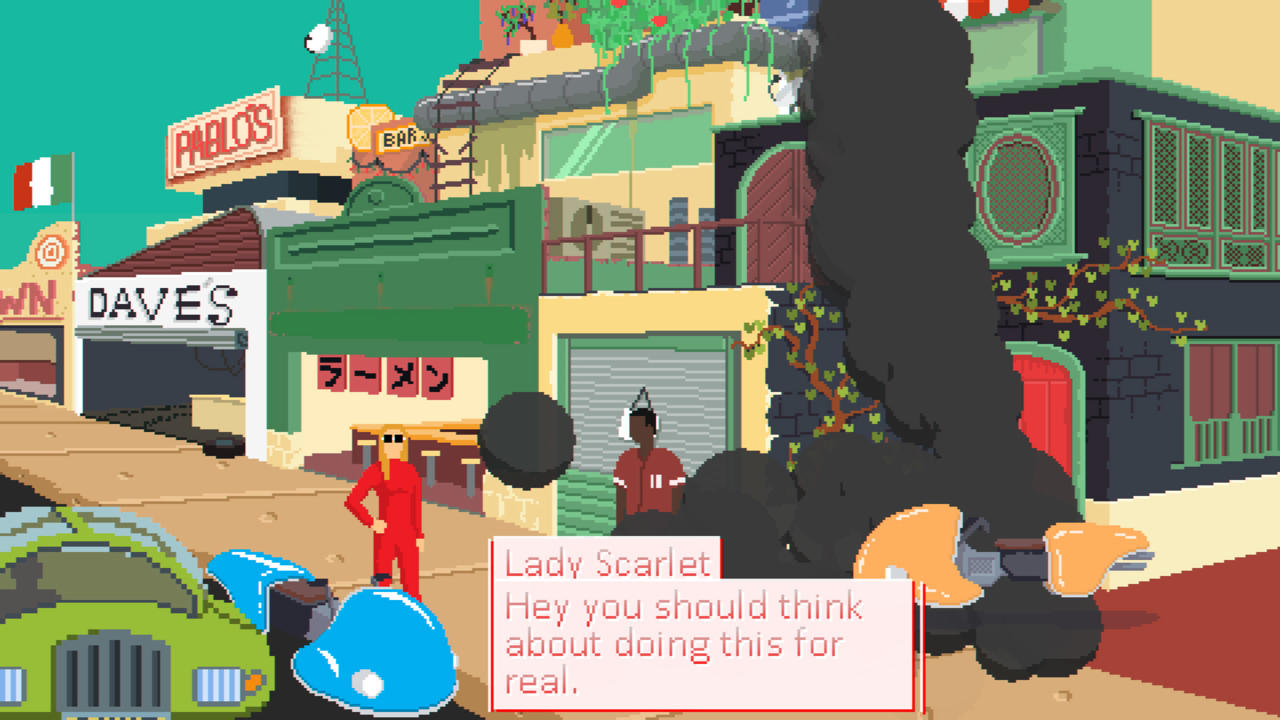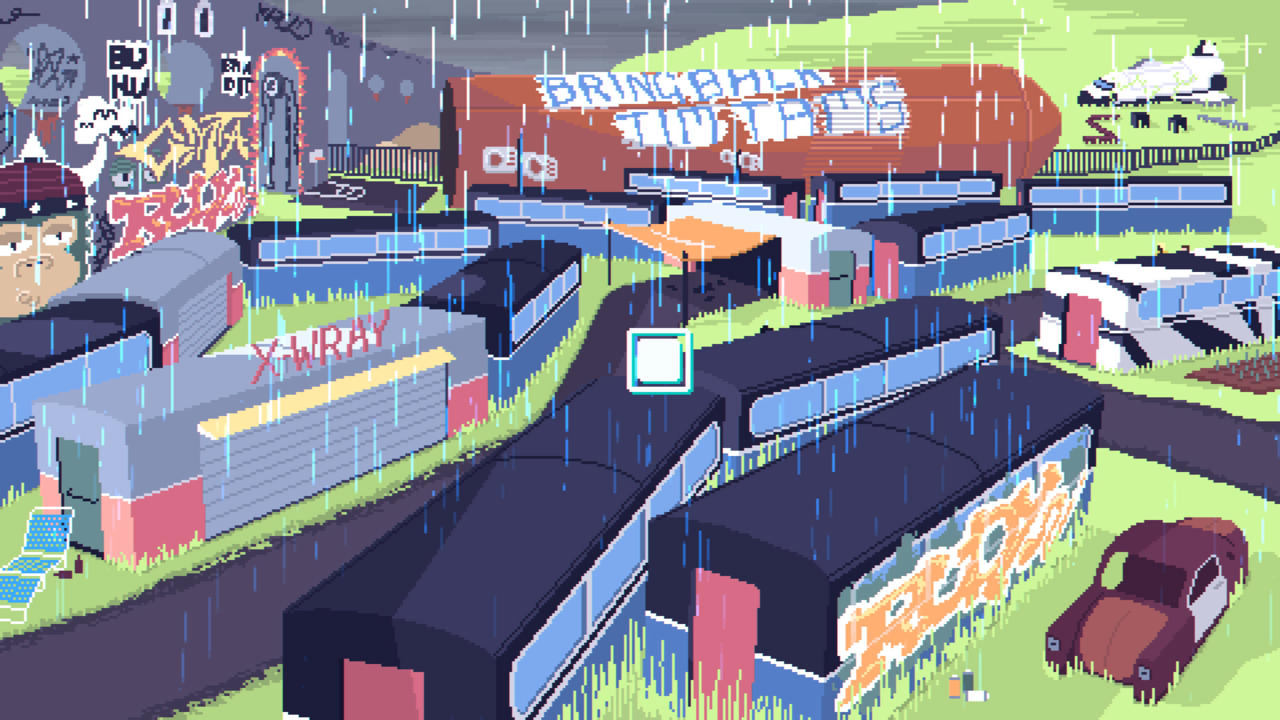Desert Child is a game of modern ambitions and sensibilities wrapped up in a retro aesthetic. It looks like an early-'90s DOS game rendering of a future where humanity has colonized Mars and built a city that feels like a mix between a Cowboy Bebop planet and modern-day Australia. The game's unique look, chilled vibe, and strong concept make for a great first impression, but unfortunately, by the end of it you'll realize that there's not much more to Desert Child than what you got in those opening minutes.
You play as a young man who leaves Earth in the game's opening, looking to conquer Mars' speeder bike circuit and earn enough money to prove himself in an upcoming championship. At the beginning of the game, you choose between four weapons to have mounted on the front of your vehicle, each with a different difficulty rating depending on how useful they are. All races are one-on-one and play out on a 2D plane viewed from a side-on perspective, which is a strange--but also a strangely enjoyable--way to compete. There are a handful of different tracks, all with unique obstacles, and when you start up a race you'll be thrown into one of them at random. While there are obstacles to avoid, winning comes down to using your boost effectively and firing your weapon at TVs planted around the track. Each TV you take out gives you a speed boost, and to maintain your maximum speed you need to consistently destroy the televisions on the track before your opponent does.
The first few times you race in Desert Child, it's thrilling. Your hoverbike controls well--it's floaty and fast but precise--and blasting away at everything in front of you and timing your boosts well is fun. The game captures the inherent excitement of hoverbike racing, but once it becomes clear that every race is going to be more-or-less the same, that excitement dulls considerably. You can't switch guns mid-game, the tracks all play very similarly, and the only real difference between opponents is that the very last one in the game is more difficult to beat than the others. I couldn't highlight a uniquely cool moment from any of the races I took part in across two playthroughs of the game, or a race where the game showed off a new trick or idea.
Desert Child also has the thin veneer of an RPG system. You spend much of the game's short running time wandering around a Martian city, exploring and poking at its different stores, NPCs, and the odd jobs it offers. There are only a handful of different environments for your unnamed protagonist to mosey through, and while they're lovely to look at the first few times, the game's small scale begins to feel limiting when you realize that the game world never changes in any significant way. After each race or job you take, the day progresses, and while some NPCs shift around and store stocks change, Mars very quickly starts to feel small and static.

Your major objective is to raise $10,000 for a tournament while keeping yourself well fed, your bike in good working order, and not attracting the law by taking on too many dodgy missions in the nightlife district. The goal seems to be to capture some of the tedium of life in this town--there's a lot of walking around, visiting ramen stores, and switching between odd jobs. Some of these jobs are fun, but generally only for the first few times that you play them. For example, you can work as a pizza delivery person, riding a bicycle through one of the game's tracks while shooting pizza boxes at people; you can herd kangaroos, which involves following a group of them through a field and maneuvering your hoverbike behind any slackers so that they don't drop away from the pack; you can enter and intentionally lose a race for the local crime boss.
There are a few different minigames like this, but ultimately none of them really offers anything that feels like a meaningful twist on the existing racing (with the possible exception of the "hacking" minigame, in which you're attacked by floating Windows logos and marble busts--I could not figure out this job's victory conditions). Once you've quickly seen everything Mars has to offer, and especially once you've bought the game's entire soundtrack from the record shop (which is worth doing, because the music is great), there's nothing exciting to find or unlock.

There are a lot of references in Desert Child that will hit harder with an Australian audience. There's a bridge dedicated to the welfare program Centrelink, complete with a job board that you can access different tasks from; the constant casual profanity is very Aussie; and there are little nods to local cultural touchstones dotted around Mars. The "Bring Back Tim Tams" graffiti might not hold the same appeal for all players, but it made me smile.
Before long, your focus will shift to saving up for the tournament, which boils down to racing and completing tasks over and over while storing your earnings in your bank to accrue interest. It's an uninteresting progression model, and the tournament itself is unexciting--you race three times, and if you lose any of them you must start again. You earn huge amounts of money even if you lose the first two races, which lets you buy all your hoverbike's potential upgrades and make things a bit easier on yourself. Winning the third race promptly ends the game, even though, narratively and mechanically, it really feels like things are just getting started.

Desert Child exhibits a number of smaller issues, too. While the numerous misspellings feel like they could plausibly be an intentional part of the game's aesthetic, the lack of a pause option during races feels like an oversight, as does the fact that selecting "New Game" from the menu automatically starts up a new game without warning you that all previous data is going to be erased. Sometimes the equipment I'd put on my bike, like a laser sight for my gun, arbitrarily wouldn't work during a race, and I could never figure out why there were TVs scattered around during the pizza delivery game with seemingly no way to destroy them. Problems like this pop up all over Desert Child, and while most of them are minor, they add up.
Desert Child has a wonderful sense of style, and there are moments when it clicks. When you jet across the water on your bike firing a shotgun blast that shatters several televisions in front of you, or when you first start to wrap your head around the aesthetic of Mars, the game briefly, but brightly, shines. But Desert Child doesn't quite hang together, and by the end of its very brief runtime the things that seemed exciting just an hour prior have lost most of their luster. This could be a lovely proof of concept for a bigger game; as it stands, it's hard not to get caught up thinking about all that it could have been.